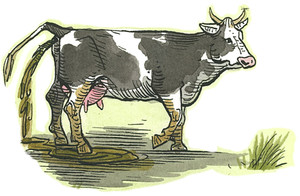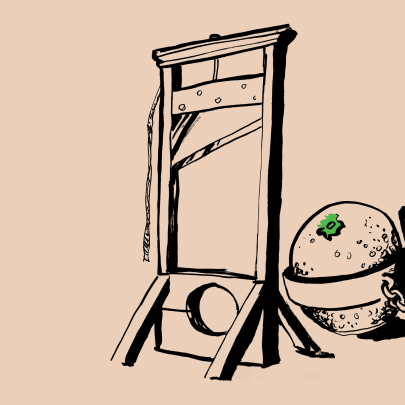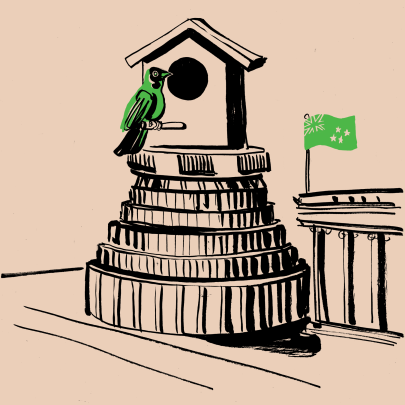Aug 26, 2014 Politics
Never mind the grandstanding, the name-calling and the downright lies, what are the real differences likely to be between a National-led centre-right government and a Labour-led government of the centre-left?
First published in Metro, July 2014. Illustration by Anna Crichton.
Forget all that stuff about charity auctions and politicians who don’t know who they’ve met or written letters about. Forget charter schools. Forget flexible dinner breaks for factory workers. Not important. This election is all about dairy.
I know, cows are not sexy, even the good-looking ones. But what happens to dairy — to the farms, the technology, the milk products and the markets — is what happens to the country. And dairy is where many of the differences, and some striking similarities, between the major parties are made clear.
The dairy industry accounts for 30 per cent of exports; or 22 per cent of “net exports”, as Steven Joyce, Minister for Economic Development, likes to put it. Our milk and milk products sold overseas are worth $13.7 billion a year. Dairy holds the key to economic stability, environmental values and wealth creation.
So, the average dairy farm? That would be a couple on a small holding in the Waikato, up in the cold misty dawn (black night, this time of year); a few score of cows wandering the path to the shed twice a day; a lot of quiet, contented munching in the fields. And cowshit, of course. Gumboots and a thermos. A small family operation.
Well, no. Not these days. The average dairy farm in New Zealand is now worth $10 million and a quarter of all herds have more than 500 cows. Cow cockies have become substantial operators, and dairying, as Labour’s finance spokesperson David Parker said in a lengthy interview with Metro, is “a sophisticated business”.
He said it admiringly. Part of the sophistication is that greenhouse gas emissions (mainly methane) have, according to Climate Change Minister Tim Groser, been reduced by 24 per cent per cow since 1990, when the Kyoto Agreement was created. That’s good science working there, and it’s actively supported by the government, which has identified reducing methane emissions as something in which we can lead the world.
But New Zealand’s overall level of emissions is up 25 per cent in the same period (under the Kyoto Protocol it is supposed to be back at the 1990 level), and dairy is partly to blame: it’s up 55 per cent. Each cow farts less but, in the past five years, a million more of them have been out there farting.
There are no economic incentives for farmers to do anything about this, because agriculture is excluded from our Emissions Trading Scheme, as it is from worldwide efforts to reduce greenhouse gas emissions.
“We’re not against dairy. But we do think they should clean up after themselves.”
Dairy also pollutes the waterways: according to the Ministry for the Environment, 45 per cent of our “monitored popular freshwater swimming spots” are now graded poor or very poor. As Parker says, “You can swim, but there are places now where you can’t let your dog run along the riverbank, because it might die from something it eats.”
Labour proposes to remove dairy intensification as a permitted activity under the Resource Management Act (RMA). That won’t mean intensification is banned, but it will mean farm owners wanting to do it will have to satisfy tougher requirements than now. “We’re not against dairy,” says Parker. “But we do think they should clean up after themselves.”
National, conversely, wants to amend the RMA in the other direction, to give “economic goals” equal status with “environmental goals”. Minister for the Environment Amy Adams says, “We can ill afford a regime that acts as a disincentive to sensible development and investment.”
(The only reason it has not done this already is that it has not managed to get a majority coalition of support in Parliament: the Maori Party and Peter Dunne both oppose the move.)
Labour says the RMA has served us well for 23 years, during which time the economy has grown by 75 per cent. It also plans some other changes to the RMA, which Parker says will “standardise and simplify” the processes.
The future of the RMA is a big difference between National and Labour.
The RMA debate points to a more fundamental difference between the centre-right and the centre-left. National says because the key to future prosperity is growth and jobs (already we’re hearing that mantra a lot), environmental considerations must be tailored to fit the goal.
Labour, on the other hand, says aligning economic and environmental goals is what will provide us with jobs and growth. That’s the key to prosperity. David Parker calls this one of his “core values”.
From National’s perspective, an ongoing incremental approach to change serves us best. As Steven Joyce told his party’s Northern Region conference this year, it is “careful and considered reform” that will allow us to “lock in the gains New Zealand has earned over the last six years”.
Labour’s position implies we need a pretty big rethink about how the economy works.
And yet, while they scoff at each other, there are many examples where they both drift towards the middle. Take the Mackenzie Agreement, which sets guidelines for farm irrigation (and intensive dairying) in a part of the South Island’s Mackenzie Basin. It’s the result of a deal brokered last year by Guy Salmon, who advises Conservation Minister Nick Smith, and the Land and Water Forum, which is a consensus-building group of 62 organisations including everyone from Fonterra to Forest and Bird.
Labour and the Greens have both opposed the agreement, but that may be just politicking: the government’s Waitaki MP, Jacqui Dean, was instrumental in the process. Because, on the face of it, the Mackenzie Agreement is a very good example of how economic and environmental goals can be brought together.
Conversely, despite Green objections to expanding the use of fossil fuels, Labour is not opposed to deep-sea mining — although it does want greater environmental safeguards built into the approvals process.
It’s not just in environmental issues that dairy is a paradigm for the larger economy. Dairy is an industry overwhelmingly dominated by one company, the farmer-owned co-operative Fonterra. Everyone likes to say Fonterra is responsible for 30 per cent of the world’s dairy exports, which is true, but misleading. It’s actually a very small company in the dairy world, accounting for just four per cent of global production. The disparity is because around 92 per cent of milk products are consumed in the country where they’re produced.
National’s steady-progress approach means Fonterra will continue to invest in technology (to improve milk production as well as environmental outcomes), but not anywhere near the level of competitors like Nestlé, or some Chinese firms for that matter. It will continue to buy and build plants offshore, while watching foreign companies buy rural land and build processing factories here — as the Chinese firm Yashili has done with its infant formula plant in Pokeno. And it will continue to rely mainly on the commodity export of milk powder.
It’s hard to say the word “genetics” around most people in the Greens movement and get a good hearing.
The Labour alternative is to focus far more investment on the high-tech potential. That would mean that the dairy industry in New Zealand, over time, would not be based on the conversion of ever more New Zealand farmland to dairy, just so it can export milk powder. It would instead become a high-tech developer of low-emissions farming, super cows and sophisticated milk products — food and pharmaceuticals — here and all over the world. Nutrigenomics is the phrase: the science of the links between nutrition and genetics.
It’s no idle thought. There are 7.4 billion people in the world this year. By 2050, the number is expected to peak at 9.5 billion. Feeding everyone won’t even be possible if the plan is just to keep converting land into pasture and crops. We, the world, will need better use of existing farmland to produce better foods. That’s the opportunity for New Zealand.
Of course, it’s hard to say the word “genetics” around most people in the Greens movement and get a good hearing. Labour may not be able to help the scientific refocusing of the dairy industry as much as it might like. Which means, while it’s easy enough to see what might be done, it’s much harder to know how different Labour really would be from National in this.
One more thing, before we leave the cows. It’s our Emissions Trading Scheme (ETS), a mechanism that’s supposed to allow the market to help us reduce carbon emissions. It was created by Labour’s David Parker and introduced by National’s Nick Smith, and it’s rubbish. Commentators on all sides agree it makes few demands on anyone, has a negligible impact on carbon emissions, and is open to opportunistic abuse. Polluters can make money out of it.
While our dairy industry is relatively efficient, our ETS is ranked worst in the OECD.
Tim Groser, who is Minister of Trade as well as being in charge of Climate Change Issues, argues we shouldn’t change it. He says we already have “the most carbon-efficient agriculture in the world”, we have a negligible impact on climate change and a “credible position” that is “geared to a global response”. In other words, we should do no more about the problem than anyone else.
Worse, he says, if we did beef up the ETS, it would simply force polluters overseas where they would be subject to even fewer controls. “We don’t want our cows shipped to China to produce milk there.”
As Labour and the Greens have both pointed out, while our dairy industry is relatively efficient, our ETS is ranked worst in the OECD. We used to lead the world but, contrary to what Groser says, now we’re not even keeping up.
It’s curious that Groser continues to argue like this. He of all people knows the value of New Zealand taking a leading role in international affairs. He’s been enthusiastically engaged in it himself for many years — playing a big role in our leadership at the World Trade Organisation, in various free-trade talks, and right now in seeking a seat on the UN Security Council.
New Zealand’s negligible contribution to greenhouse gases isn’t the issue. But our potential to develop viable world-leading methods to combat climate change could be.
David Parker says, “There should be a price on carbon.” He favours a more effective ETS; the Greens favour a carbon tax. One way or another, a Labour-led government would be committed to using market incentives to reduce carbon emissions. That’s another difference between the two sides.
Enough of cows. In so many ways, National and Labour are strikingly alike. An election-year budget that projects a surplus by early 2015, that contains few new spending programmes yet does promise free doctor visits for all primary-school children, that foreshadows no significant changes to the tax base, fiscal policy or big social programmes like the age of National Super… which party was that again?
Labour does have a markedly different set of monetary policies from National. It proposes a capital gains tax (though not on the family home), whose primary aim is not revenue collection, but to encourage less investment in property and more in the productive economy. National remains vehemently opposed.
Labour will not scrap the Reserve Bank’s low-inflation target but it will introduce more tools than just interest rates to control inflation, including making KiwiSaver compulsory and using savings levels to moderate economic pressures.
Steven Joyce, interviewed twice for this story, says flatly, “There is no way in which you can change the Reserve Bank Act to achieve what Mr Parker thinks you can achieve.” He adds that using interest rates to control inflation is fair to everyone, because everyone gets hurt by rising prices. But he also agrees that it is “not wrong to consider things”.
In fact, David Parker’s package of monetary reforms has been widely praised for introducing fresh thinking into monetary debates, and its underlying goal — to boost the productive economy — is completely orthodox.
The differences appear stark because economic management skills are at the heart of the credibility of any party wanting to form a government — so neither side loses a chance to heap abuse on the other. But both parties are committed to the core principles of the Reserve Bank Act (introduced by Labour in 1989), which gives the bank independence from government and charges it with using monetary levers to keep economic activity under control.
Nobody is going to let inflation gallop away on us.
If the election is all about dairy, it’s also about Auckland.
Two thought experiments. The first: what promises is John Key going to keep if he wins again? Key is admirably committed to his own promises: he said he wouldn’t raise the age of National Super and he hasn’t; he told us how he would sell down some state assets, and he did it the way he said.
But this election? He hasn’t made any promises at all. National is not talking about its big plans, whatever they might be.
If the election is all about dairy, it’s also about Auckland. The city has a third of the population (and over a third of the MPs), almost all the country’s projected growth, fast-changing demographics but relatively slow-changing economic activity, and so many opportunities to make a better city.
The biggest roading project in New Zealand history, the Waterview tunnel motorway, was a Labour initiative, but these days Labour opposes National’s focus on the “roads of national significance” (RoNS), some of which, as Parker says, “meet none of the economic objectives that are supposed to make them significant”.
In 2006 under Labour, he adds, “53 per cent of highway projects had a high benefit-cost ratio and zero per cent had a low one. In 2010, only three per cent of this government’s projects were high and 68 per cent were low.”
However, the National government has been the main funder of Auckland’s rail electrification and the Northern Busway: if it does less for public transport than advocates hope, it still does more than many critics think.
The country is brimming with architects and builders desperately keen to develop cheap, quality housing.
Labour is committed to an early start to the underground City Rail Link, which will enable all three main lines to carry a greater number of trains. That one thing marks an enormous difference. The biggest single issue in transport planning, however, is not a project but the role of the Transport Agency in Wellington: instead of being charged with integrated planning across all transport sectors, it looks at roads on their own. This is a redundant approach to strategy. National is comfortable with this. Will Labour be? Parker was non-committal.
Finance Minister Bill English made a spectacularly ignorant statement last month when he said that to build affordable housing in Auckland they “might have to get a little ugly”. State houses in this country were not, in the main, “built ugly”, but were respectable modern homes of the time, constructed through what is now known as a public-private partnership. The country is brimming with architects and builders desperately keen to develop cheap, quality housing — and they have lots of ideas on how to do it.
National shows more foresight on the education front. Despite her penchant for rubbing everyone up the wrong way, Education Minister Hekia Parata’s programme to enable expert teachers and principals to share their skills with others is the single best initiative in schools for years. There’s a great deal of politicking involved in the primary sector’s opposition to the plan, but the secondary sector is in favour — which gives Labour an interesting conundrum: which of those traditional Labour support groups will it choose to antagonise?
National’s problem here is less about policy than the functional abilities of the minister, and fixing that is really all that stands in the way of substantial progress in the problem areas in our schools. Both sides are eminently capable of making that fix, though it’s a moot point whether either actually will.
As for the container port, it is true that the government has no nationwide strategic plan for ports and related transport, but nor does Labour. The problem is, any plan is going to outrage someone, because it will involve making some ports much more important than others.
And the university? Labour will not change the funding much at all.
Immigration is a realm of surprising difference, though. National welcomes wealthy immigrants, seeing in them vital economic opportunity — not just for investments they make here, but for trading connections they may help with in their countries of origin. We’re talking China, of course. Labour’s David Parker, perhaps taking inspiration from New Yorker economics columnist James Surowiecki, argues that “foreigners who do not live here” should not be able to distort land and house prices to the detriment of New Zealanders wanting to buy their own home.
It’s a super-difficult territory to debate public policy in, and in this country we’re really hopeless at it. But we do need to get better. Apart from anything else, while Tim Groser is right that our carbon emissions in themselves are not a big issue in the scale of things, the biggest impact climate change will have on this country may be in vastly increasing the number of people who want to live here. Strangely, given its recent history of Brashian race debates, right now National seems to have a surer footing in this terrain.
The tail does not wag the dog, though lots of commentators like to say it does. After six terms of MMP government, with both main parties in power, neither had made major concessions to its support parties. That’s one reason small parties struggle once they become involved with government: they can’t really get their way, so their supporters lose heart.
So when National scaremongers about the Greens and Internet Mana, and Labour scaremongers about Act and the Conservatives, relax. A Labour-led government will not do Kim Dotcom’s bidding, any more than a National-led government will indulge Colin Craig’s weirder fantasies.
How good is it now? Steven Joyce says economic growth “will be one of the fastest in the OECD this year” and suggests it is “picked by some to reach four per cent”. And, he says, “Goods exports have just had their biggest quarter ever; and the goods surplus for the last six months is over $2 billion.” Unemployment is down, on the back of the “largest annual increase since 2006”. The cost of living rose by just 1.5 per cent last year and mortgage rates are under six per cent. The country is out of recession and business confidence is high.
In fact, the Reserve Bank forecasts growth to peak at 2.7 per cent in the current financial year, then fall to two per cent in 2015 and 1.1 per cent in 2016. And our trading partners are outstripping us with growth commonly at 3.5 per cent to four per cent a year.
If free doctor visits for primary-school children were extended to the age of 18, it would cost only another $29 million.
The argument comes down to this. Either: what we’ve got feels good, so why change that — we’ll keep adapting to make the best of things, won’t we? Or: what we’ve got will not take us where we want to go, and it doesn’t feel that good either, not if you’re stuck in traffic, trying to stretch a low wage or benefit, or even taking the dog for a walk in the country.
But if the long-term view of the two parties seems quite different, up close and in campaign mode, that’s much less true. Here’s another thought experiment. Those free doctor visits for primary-school children: if they were extended to the age of 18, it would cost only another $29 million. Grant Dalton could sell a couple of motorbikes and just about pay for it. It’s cheap, and it’s so obviously sensible. And currently, it’s Green Party policy. During the election campaign, which of National and Labour is more likely to adopt it as their own? You have to admit, they both might.






